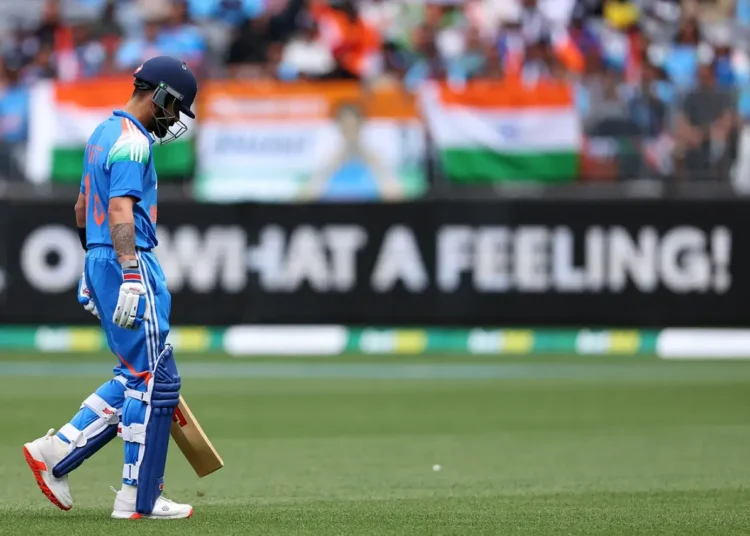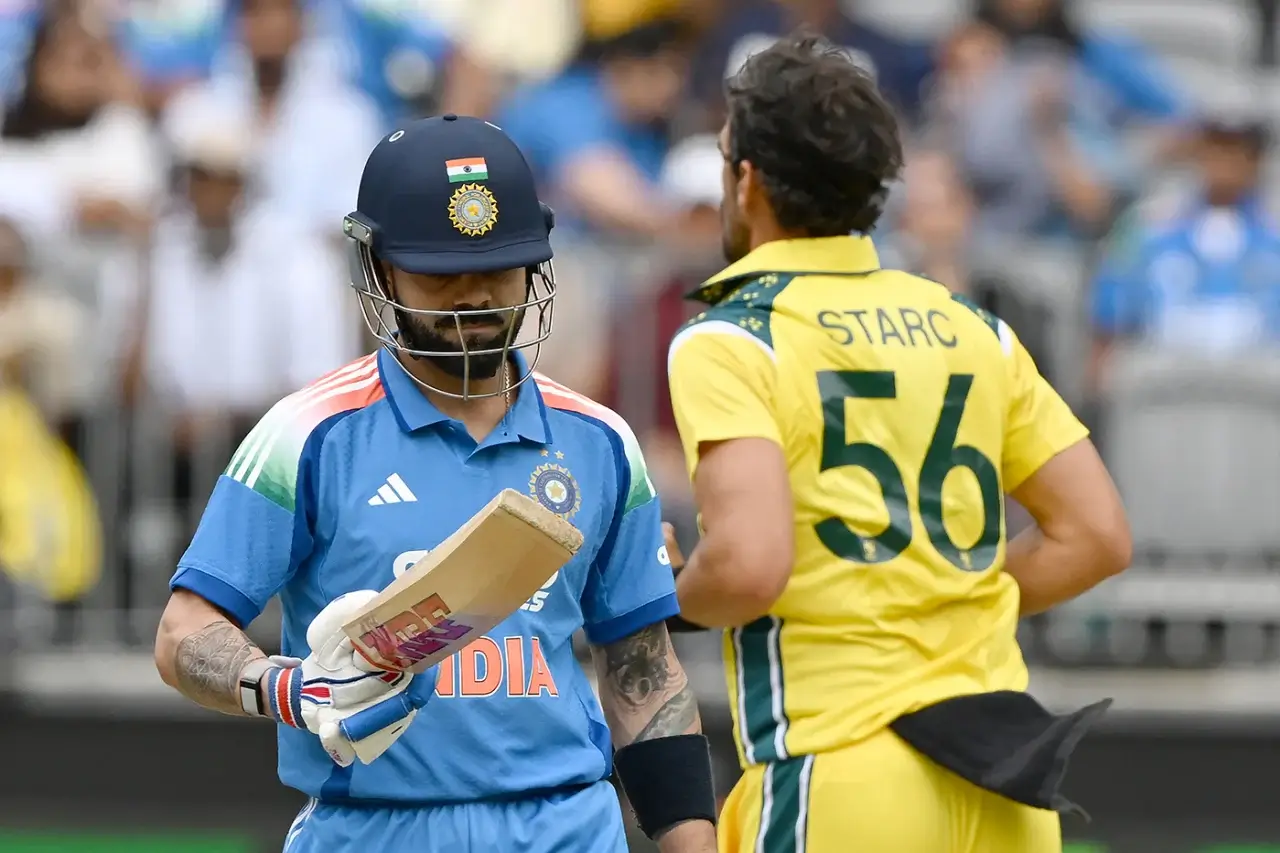Mohammed Siraj gave fans the night’s most electric moment in Perth. His lightning-fast dive at the boundary turned a certain four into a jaw-dropping save. While India’s fielding sparkled briefly, their batting disappointed. Both Rohit Sharma and Virat Kohli returned to the ODI stage but failed to make an impact. Their early dismissals left India reeling in conditions that demanded patience and control.
Siraj’s moment of brilliance summed up the contrasting energies within the team. India’s fielding intensity was world-class, but their top order lacked rhythm. Rohit nicked early, Kohli edged for a duck, and the rest followed under pressure. The Australians capitalised quickly, maintaining tight lines and energy in the field.
Fans expected India’s experienced duo to set the tempo after months away. Instead, their short stay brought back familiar questions about India’s adaptability in foreign conditions. Siraj’s commitment, however, provided a silver lining. His save lifted spirits briefly, reminding everyone how fielding can change momentum even without wickets or runs against the Australian team.
The Perth ODI became a tale of two extremes — one of athletic brilliance and another of rusted batting. As India looks toward the next game, it must translate Siraj’s effort into collective energy. Otherwise, moments of brilliance will remain isolated flashes in losing causes.
Siraj’s Stunning Save Sparks Energy Amid India’s Early Struggles
Mohammed Siraj’s boundary stop was the highlight that electrified the Perth crowd. The ball was destined for the fence before Siraj sprinted, dived full length, and scooped it back inside. His precision, balance, and presence of mind drew applause even from opposition players. It wasn’t just a save; it was a statement.
Siraj’s timing was perfect because India was already wobbling. The bowlers needed inspiration and the fielders needed a lift. That single act of athletic brilliance gave both. Australia, cruising early, paused for a moment as the crowd erupted. Siraj’s commitment displayed the modern standard of elite fielding India aspires to achieve more consistently.
It also showed how India’s younger generation is redefining intensity. For years, India’s batting stars carried the spotlight, but now fielding brilliance is taking equal importance. Siraj’s save reflected new-age awareness and discipline — small margins deciding big games. His effort became a symbol of hope amid India’s fading batting show.
Why That Save Meant More Than Just Two Runs?
Fielding moments like Siraj’s have deeper value than statistics reveal. That save didn’t just prevent a boundary; it reignited a team’s belief. When top batters like Rohit and Kohli failed, energy from the field became crucial. Siraj’s awareness lifted India’s morale even if the scoreboard didn’t reflect it.
Such plays can shift narratives in tense matches. They remind players that commitment counts even in losing causes. For India, it was a lesson in how small efforts can keep pressure alive when batting fails.
Rohit and Kohli’s Return Ends in Early Disappointment
Rohit Sharma and Virat Kohli’s returns were supposed to anchor India’s innings. Instead, both fell cheaply. Kohli was undone early, nicking behind without scoring. Rohit followed soon after with a tentative push that found the slips. Their dismissals left India 20 for 2 and in survival mode.
For fans, it was disheartening. Both had prepared hard, hoping to restore India’s ODI stability. But rust showed. Their footwork looked heavy, timing uncertain, and decision-making blurred under bounce and movement. Against Australia’s sharp bowling, they appeared half a beat slow.
Critics might call it a one-off, yet this pattern has lingered too long. India’s dependency on the same core continues to expose their fragility. When Rohit and Kohli fail, the middle order struggles to absorb pressure. The result: collapses like Perth repeat themselves. For India to evolve, they must build new anchors while the veterans rediscover fluency.
Siraj’s energy in the field showed what focus and adaptability can do. Rohit and Kohli, legends that they are, must now channel that intensity into batting resilience.
Signs of Rust or Simple Bad Luck?
Kohli’s dismissal off a rising delivery looked technical, not mental. Rohit’s early nick came from indecision rather than poor form. But both lacked the time and patience needed in alien conditions. Rust after long breaks often causes hesitation between front and back foot. Perth’s bounce exaggerated that flaw.
They will need more practice sessions and fewer loose shots in upcoming ODIs. India can’t afford both openers misfiring if they aim to dominate this series.
Australia’s Discipline and India’s Missing Calm
Australia’s new-ball bowlers used seam and bounce masterfully. Every over tested India’s judgment. Their fielders supported perfectly, cutting singles and attacking ground balls. In contrast, India’s batting appeared restless. Instead of adjusting, they forced shots against movement.
The contrast was clear. Australia valued patience; India chased pace. As conditions worsened, the difference widened. What Australia did consistently was sustain pressure without giving freebies. Their body language stayed sharp, matching Siraj’s lone spark with collective effort.
India, on the other hand, looked disconnected. Fielding had moments of brilliance, but their batting rhythm never matched it. Communication between pairs seemed off, and the middle order added little resistance. Australia exploited that uncertainty ruthlessly.
If India want to bounce back, they must learn from Australia’s control. The answer lies not in flashy shots but in adapting mentally to the rhythm of conditions.
Lessons India Must Learn Before the Next ODI
India must simplify their batting approach and read conditions faster. Big names need early patience rather than instant domination. Rotating strike and avoiding panic can rebuild innings when early wickets fall. Fielding brilliance means little without batting support.
Australia showed that intensity and composure can coexist. India needs to bring both to the next match or risk another repeat of Perth’s collapse.
Conclusion
Siraj’s extraordinary boundary save lit up Perth, showing what commitment looks like under pressure. While India’s fielding produced one of the night’s most replayed moments, their batting fell apart when it mattered. Rohit Sharma and Virat Kohli’s early exits set a tone of uncertainty that India never recovered from.
Australia controlled the game with discipline and confidence. India had glimpses of excellence, but nothing consistent. Siraj’s save became a symbol of contrast — one man’s brilliance against a team’s broader struggles. It also highlighted how modern cricket values every run saved as much as every boundary scored.
For India, this match must serve as a wake-up call. Veterans need rhythm, younger players need focus, and the collective mindset needs balance. Fielding intensity like Siraj’s can’t stand alone; it must inspire entire performances.
The next ODI offers a chance for redemption. If India convert flashes of brilliance into complete efforts, they’ll stay competitive. Otherwise, they’ll keep chasing highlights instead of wins. Either way, Siraj reminded everyone that cricket is no longer just about bat and ball — it’s about total awareness and effort across every inch of turf.






